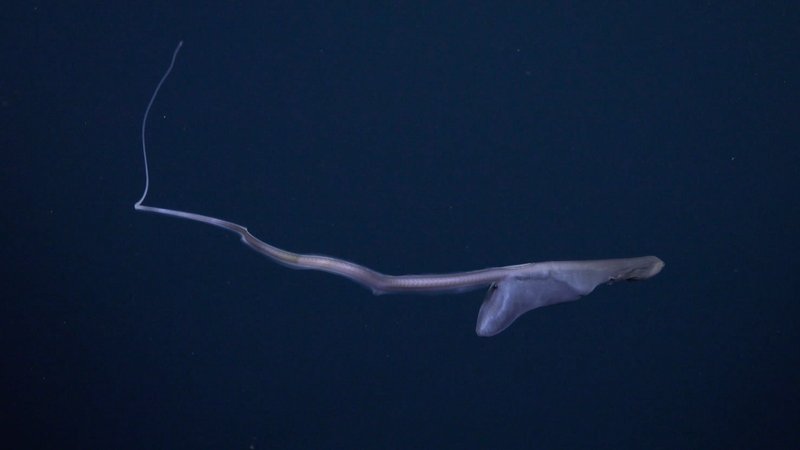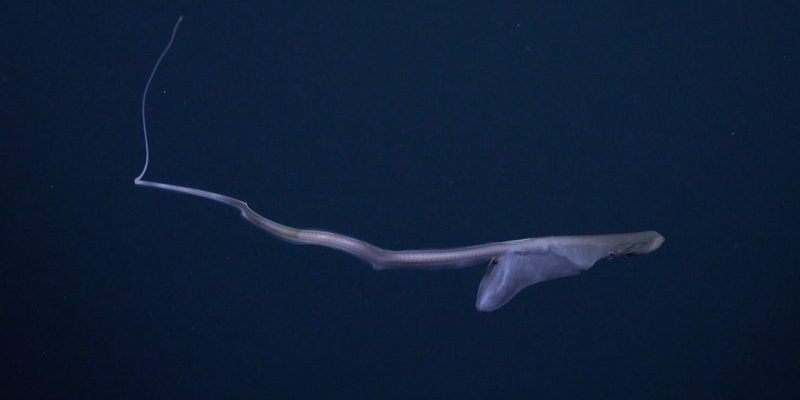
The Gulper Eel is one of the ocean’s fascinating and somewhat bizarre creatures. Imagine a creature that looks like it was designed for a sci-fi movie! With its long, slender body and a mouth that can stretch wide enough to engulf prey whole, it’s not your typical fish. Living in the deep sea, this eel remains mostly a mystery to researchers, which only adds to its allure.
You might be wondering what makes this eel so special. For starters, its unique feeding mechanism and adaptability to extreme ocean depths set it apart from many other fish. The Gulper Eel can often be found in the dark, cool waters of the deep ocean, where light barely penetrates and where most sea life is still largely uncharted territory. Let’s dive deeper into this intriguing creature.
Physical Characteristics
The Gulper Eel has some truly remarkable physical features that make it stand out. Its body can grow quite long, typically reaching lengths of around 6.5 feet (2 meters), although some have been recorded even longer. What’s most interesting is its astonishingly large mouth, which can open up to an incredible width. This unique feature allows the Gulper Eel to consume prey much larger than itself.
Its skin is also quite unique—often a muted brown or gray, which provides excellent camouflage in the dark depths of the ocean. This coloration helps it blend in with the rocky or sandy bottoms of the sea floor, making it a stealthy predator. Additionally, its thin, elongated body allows it to navigate through tight spaces in search of food.
The Gulper Eel possesses a long tail, which aids in propulsion through the water. This tail isn’t just for show; it’s essential for making quick movements when hunting or evading predators. Overall, its striking appearance is a combination of functionality and beauty, drawing the eye of anyone lucky enough to glimpse this shy creature.
Habitat and Distribution
Gulper Eels are typically found in the deep-sea regions of the world’s oceans. They prefer deep waters, generally ranging from around 1,000 to 3,000 feet (300 to 900 meters) below the surface. This environment is harsh and dark, but it’s where they thrive. You’ll find them closer to the bottom of the ocean rather than near the shoreline, as they prefer areas where they can hide from predators and ambush prey more effectively.
These eels are distributed in various oceans, including the Atlantic and Pacific Oceans. Researchers have spotted them in multiple locations, from the Caribbean Sea to the northern waters off the coast of Japan. However, due to the depths at which they live, they can be challenging to study, and many aspects of their distribution remain unknown.
The cold temperatures and high-pressure environment of the deep sea influence how Gulper Eels behave and adapt. They are specifically adjusted to survive in these extreme conditions, showcasing nature’s incredible ability to innovate. Understanding their habitat not only teaches us about the Gulper Eel but helps scientists learn more about deep-sea ecosystems as a whole.
Diet and Feeding Habits
The feeding habits of the Gulper Eel are particularly interesting and showcase its unique adaptations. This eel is a carnivore, primarily preying on smaller fish and squid. The way it feeds is quite remarkable—thanks to its large mouth, it can gulp prey almost whole, which means it doesn’t need to hunt small items one at a time. Instead, it can capture an entire meal in one swift motion.
Imagine the Gulper Eel with its enormous mouth open wide, ready to swallow its next meal whole. It tends to hunt at night when it can stealthily approach its prey with less risk of being seen. Once it spots a potential meal, it uses its ability to elongate its mouth—enabling it to devour prey that’s a significant size compared to its body. This efficient feeding strategy is vital for survival in the nutrient-scarce deep ocean.
Another fascinating aspect of their diet is their ability to consume a variety of prey depending on availability. They are opportunistic feeders, meaning they will take what they can get. This flexibility allows them to adapt to their ever-changing environment. Just like in life, sometimes it’s about making the most of what you have, and the Gulper Eel excels in that department.
Reproduction and Lifespan
When it comes to reproduction, the Gulper Eel remains quite mysterious. Very little is known about its breeding habits due to the depths they inhabit. However, like many eels, it is believed that they lay eggs. These eggs likely float in the water column until they hatch, but researchers have not documented this process in detail.
In terms of lifespan, Gulper Eels are thought to live several years, but precise numbers are hard to determine due to the challenges of studying them in their natural habitat. They face various threats from their environment, including deep-sea predators and fluctuations in food availability. This uncertainty in lifespan mirrors the unpredictability of life in the ocean—a thrilling yet perilous existence.
While knowledge about their reproductive cycles is limited, each new discovery contributes to our understanding of these unusual creatures. As technology advances, researchers hope to learn more about how Gulper Eels reproduce and grow, further unlocking the secrets of the deep sea.
Interesting Facts About the Gulper Eel
| Size: | Up to 6.5 feet (2 meters) |
| Habitat: | Deep ocean (1,000 to 3,000 feet) |
| Diet: | Carnivorous; primarily small fish and squid |
| Lifespan: | Several years (exact duration unknown) |
| Color: | Muted brown or gray for camouflage |
Conservation Status
Currently, there’s limited information on the conservation status of the Gulper Eel. Because they inhabit such deep and remote environments, they are less affected by human activities compared to many other marine species. However, that doesn’t mean they are entirely safe. Climate change and deep-sea fishing practices could potentially impact their populations.
While the deep ocean is often viewed as a lesser target for conservation efforts, it plays a crucial role in the health of our planet. Protecting deep-sea ecosystems ensures that creatures like the Gulper Eel can continue to thrive. Awareness and education about these unique environments are essential for conservation efforts.
Moreover, understanding the ecological role of the Gulper Eel can help promote broader marine conservation initiatives. After all, every creature plays a part in the intricate web of life in the ocean, from the tiniest plankton to the largest whales. The more we learn about species like the Gulper Eel, the better we can strive to protect our oceans.
The Gulper Eel is a remarkable testament to the wonders of marine life. With its extraordinary adaptations and elusive nature, it encapsulates the mysteries of the deep sea. Though much about this creature remains unknown, each discovery offers us a glimpse into a world that exists far beneath the waves.
As we continue to explore and learn, we uncover not just facts about the Gulper Eel, but also insights into the delicate balance of marine ecosystems. Understanding and protecting such unique species is vital for maintaining the health of our oceans. So next time you think of the deep sea, remember the Gulper Eel—a creature that’s as fascinating as it is mysterious.
FAQ
Where can I find Gulper Eels?
Gulper Eels can be found in the deep parts of the ocean, usually between 1,000 to 3,000 feet below the surface. They are commonly located in the Atlantic and Pacific Oceans, often near the ocean floor where they can hide from predators and hunt for prey.
How big do Gulper Eels get?
These eels can grow quite large, typically reaching lengths of around 6.5 feet (2 meters). Some records even suggest they can get longer, but exact measurements can be hard to come by due to their elusive nature.
What do Gulper Eels eat?
The Gulper Eel primarily feeds on small fish and squid. Their unique feeding method allows them to gulp prey whole, which is essential for survival in the often scarce deep-sea environment.
Are Gulper Eels dangerous to humans?
Gulper Eels pose no threat to humans. They are deep-sea creatures that typically stay far below the surface, and encounters with them are rare. Even if spotted, they are not aggressive and would rather avoid interaction.
How do Gulper Eels reproduce?
Information regarding the reproduction of Gulper Eels is limited. They are believed to lay eggs that float in the ocean until they hatch, but specific details about their reproductive habits remain largely unknown due to the challenges of studying them in their natural habitat.
How long do Gulper Eels live?
While exact numbers are hard to determine, Gulper Eels are thought to live for several years. The challenges of studying deep-sea species make it difficult to pinpoint their lifespans accurately.
Can Gulper Eels be kept in aquariums?
Keeping a Gulper Eel in an aquarium is not practical. They require specific deep-sea conditions that are challenging to replicate in a home aquarium. Moreover, their size and feeding habits make them unsuitable for typical aquarium settings.
Are Gulper Eels active during the day or night?
Gulper Eels are primarily nocturnal, meaning they are more active at night. During this time, they hunt for prey and navigate their environment with less risk of being seen by predators.
Do Gulper Eels have any predators?
While not much is documented about their predators, larger deep-sea fish and sharks could potentially prey on Gulper Eels. Their adaptations, such as camouflage and a unique feeding strategy, help them avoid being targeted.
What is the biggest threat to Gulper Eels?
While Gulper Eels are less impacted than many shallow-water species, they face threats from climate change and potential changes in oceanic conditions. Deep-sea fishing practices can also affect their populations and habitats.

